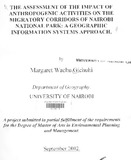| dc.description.abstract | The impact of the anthropogenic activities on the migratory corridors of Nairobi National Park was studied from 1990 - 2000. These activities were categorized as the residential areas, industrial areas, commercial activities, farming and communication lines. These anthropogenic activities have been taking pace in the Nairobi National Park neighbourhood.
Primary data was used by conducting field training at the Nairobi National Park using a GPS. Secondary data was also used in form of animal count records from 1990 - 2000, rainfall data (1990 - 2000). This data was used to study the trends in population totals of animals in the park and also the behaviour patterns. The spot image (1995) and the land-sat image (2000) were used to assess the anthropogenic changes that have taken place in the park neighbourhood for the last ten years (1990-2000). The G.I.S. was used as a computer tool to assess the impact of the anthropogenic activities on the migratory corridors i.e. Cheetah Gate, leopard cliff and South-western route through Maasai Lodge. Buffer zones were used to show the negative impact of the anthropogenic activities on the migrators.
The findings showed that the most affected corridors are the leopard cliff route and the south-western route through Maasai Lodge. At the same time the wildebeest and the zebra are most vulnerable animals since they have to migrate in and out of the park according to seasons. The study recommends a careful management of the buffer area in order to sustain traditional animal movements, minimize increasing human-wildlife resource conflict and ensure future existence of Nairobi National Park. | en |

